Scrum is not a one-size-fits-all solution, a silver bullet, or a complete methodology. Instead, Scrum provides the minimal boundaries within which teams can self-organize to solve complex problems with an empirical approach. This simplicity is its greatest strength, but also the source of many misinterpretations and myths. The Scrum Mythbusters exercise helps you address the common myths and misunderstandings about Scrum and helps teams discover how Scrum is intended as a simple, yet sufficient framework for complex product delivery.
Scrum Mythbusters is one of the first exercises we start the Scrum.org Professional Scrum Master II class with. It helps to get a sense of the experience of the group with Scrum in a playful manner, validates the knowledge, and triggers useful conversations. It proves to be such a valuable exercise, that we recommend every Scrum practitioner to use it within their own organization and team. When your team struggles with most of the statements, you can inspect by refreshing the purpose of the Scrum Framework together. You may also discover that the way your team uses Scrum is not as light-weight as it could be.
In this blog post, we share many ideas on when & how to use it. All you need is a deck of Scrum Mythbusters cards, and optionally a couple of buzzers (or things that make noise). We also offer a free digital example with 10 Scrum Mythbusters statements.
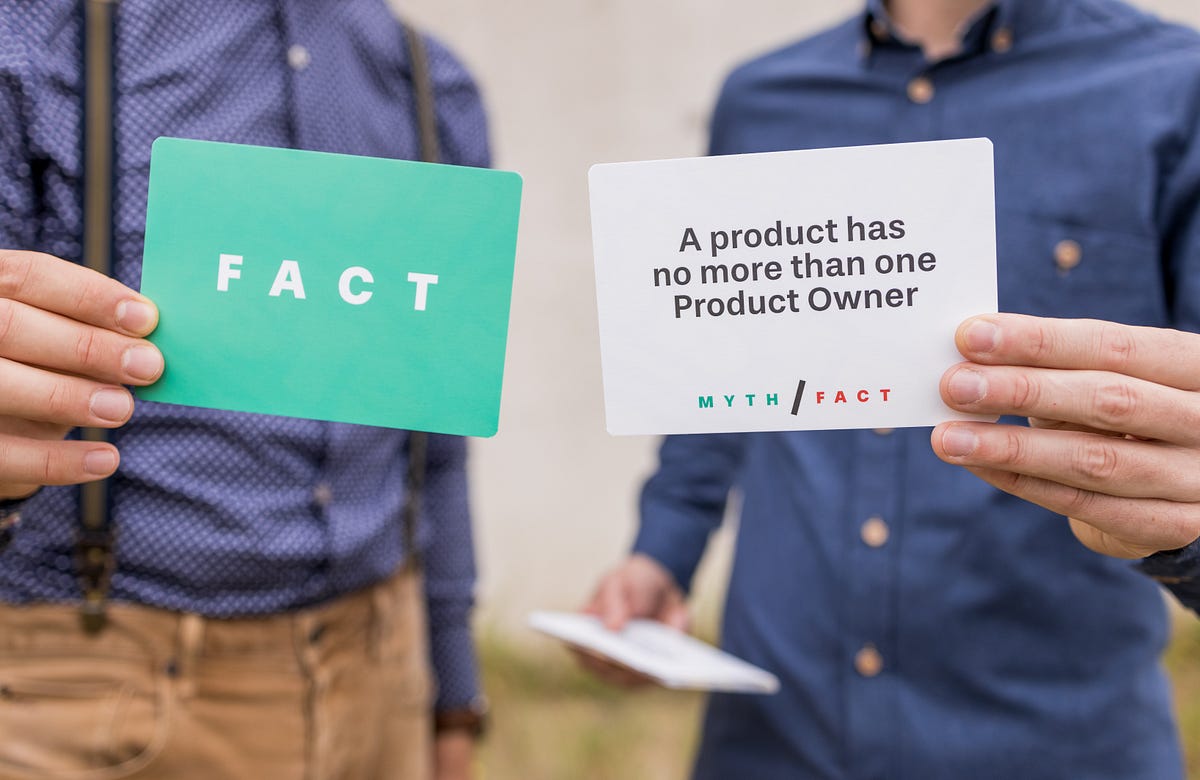
Pictures by Lisanne Lentink
When to use the Scrum Mythbusters exercise?
Finding a good opportunity to use the Scrum Mythbusters exercise shouldn’t be too difficult. You can use them for individual reflection, within your Scrum Team, or the wider organization. Some specific examples are:
- During the Sprint Retrospective. Use the Scrum Myths card deck to detect the myths that are holding back the Scrum Team. What are myths the team members noticed that really prevent them from using Scrum effectively? What needs to change in order to bust the myth? What is a good first step the team can already take in the next Sprint?
- At the start of a Scrum kickoff. When introducing Scrum within an organization, use Scrum Mythbusters to improve everyone’s understanding of how Scrum is a light-weight framework. Starting enthusiastically can sometimes result in introducing many new practices that are not Scrum, and not necessary. Scrum Mythbusters will help you trigger a good conversation about what (not) to do.
- When rebooting the Scrum Team. A common reason Scrum Teams aren’t successful is the use of unnecessary practices. Story Points are used to estimate all work, User Stories to write requirements, and a burndown chart to track progress. Although these practices can be useful, more often they are not. Start exploring what’s really important for your team, by discussing the facts & myths of Scrum.
- During a public meetup. Each card is a potential topic for a public meetup. For example, “The Development Team commits to the Sprint Backlog”, “The Scrum Master should be present during the Daily Scrum”, and “Scrum Teams release only at the end of the Sprint” will guarantee interesting discussions during your (online) meetup!
- Within your Community of Practice. Many organizations have a Community of Practice in which participants share experiences and give & get help. By sharing a short survey upfront, you can learn what the most confusing, challenging, or surprising Scrum myths are. Use the top 3 as the topic for your upcoming gathering.
- For a job interview. Bring a deck of myths to every Scrum related job interview. Simply share a card and ask the candidate to explain if its a myth or fact. Try to dig deep on the ‘why’ and not only stick to “it’s a myth because the Scrum Guide says so”. For example, what happens to empiricism when Scrum Teams only release at the end of the Sprint? How does it impact transparency, inspection, and adaptation?
- For individual reflection. Nothing beats a moment of silent, individual reflection. Just go through the deck of cards and select the ones that trigger your interest. Do some research. Maybe even write a blog post, create a podcast episode, or compose a video about it. The individual reflection and sharing of your ideas is also excellent preparation for the Scrum.org PSM I, PSM II, and PSM III assessments!
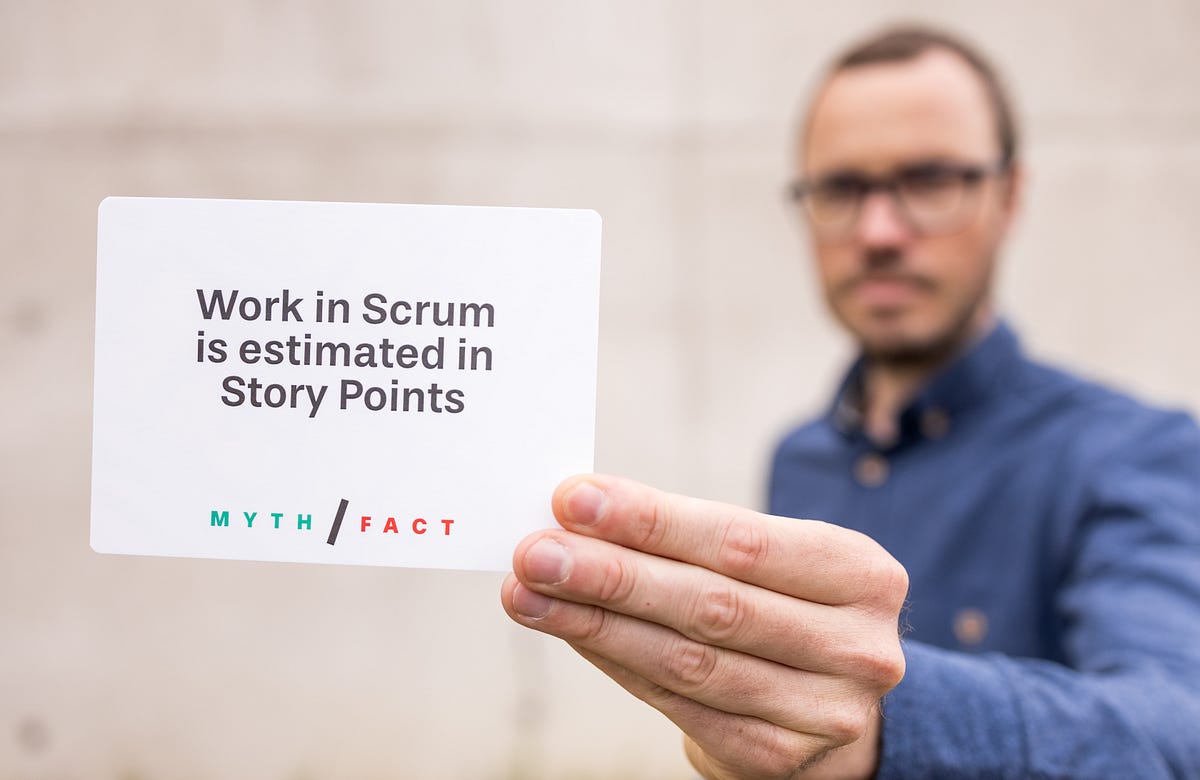
Pictures by Lisanne Lentink
How to use the Scrum Mythbusters exercise?
For the best learning experience, use Liberating Structures to structure the conversation. That way, everyone is included and can offer their perspective. You may even find creative insights to persistent you personally would never have thought of! Some examples of Liberating Structures to try are:
- 1–2–4-ALL. Only doing a 1–2–4-ALL during a session is already a good approach to explore a Scrum myth. Start with 1 minute of silent self-reflection. Take 2 minutes to generate ideas and share thoughts in pairs, building on ideas from self-reflection. Create groups of four and use 4 minutes to share and develop ideas that you’ve discussed within your pair. Notice similarities and differences. Take 5 minutes to share insights, ideas, and takeaways.
- Impromptu Networking. With Impromptu Networking, you can discuss a Scrum myth within 15 minutes. Invite the participants to stand up and form pairs. Present the myth to discuss. Within the pairs, ask people to share their answers. Signal the end of the first round and have people from new pairs. Within the new pairs, ask people to (again) share their answers. But also ask them to pay attention to similarities and differences from their previous conversation. Do one more round. After the 3 rounds, gather insights and patterns that the participants noticed.
- Future~Present. Future~Present invites groups to travel to a successful future and uncover what is needed for that today, while also appreciating what will grow into the success of tomorrow. It invites participants to take a positively novel perspective that encourages a “Yes, and”-attitude, improvisation, and out-of-the-box-thinking. This structure is therefore ideally suited to explore the Scrum Myths: “Imagine a future where all the Scrum myths have been busted. What first small steps did you take to bust the myths? How did you contribute to the change? Who supported you? Which of the myths gave you the most headaches, obstacles, or hindrances to remove? What new myths appeared?”.
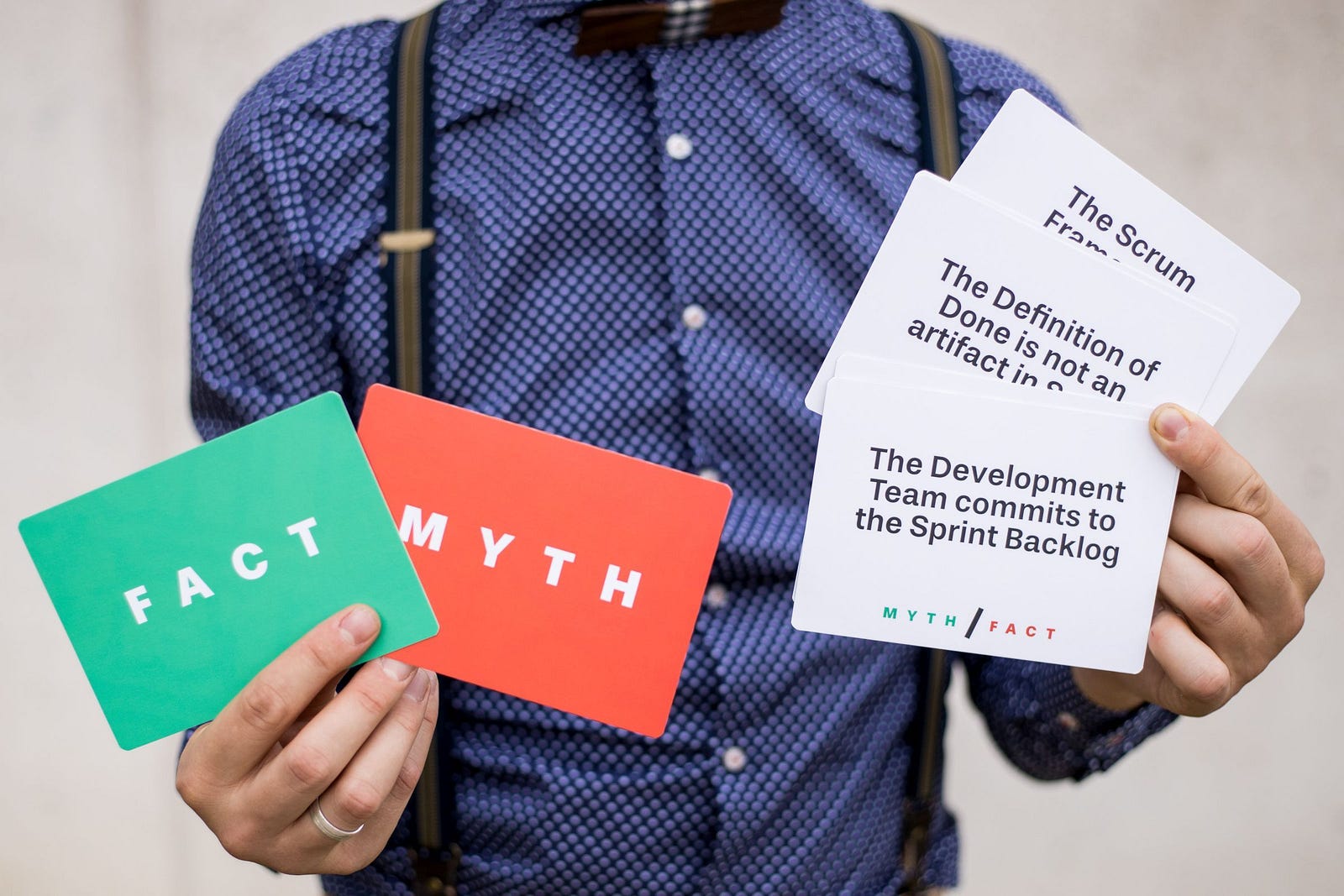
Pictures by Lisanne Lentink
- Conversation Cafe. The Liberating Structure Conversation Cafe is an ideal structure to dig into the Scrum myths. It encourages people to listen and understand each other’s perspectives instead of trying to convince or persuade others to see it your way. Sitting in a circle with a simple set of agreements and a talking object, small groups engage in consecutive rounds of dialogue. Follow-up with 15% Solutions or 1–2–4-ALL to translate learnings from the myth to your own team or environment.
- 10x10 Writing. As the facilitator, pick the 10 myths you think are most relevant for your Scrum Team. Invite everyone to get a notebook and a pen. Share the first card of Scrum Mythbysters with your team and ask everyone to write down as many thoughts they have about the myth in their notebook. Repeat until you have moved through all 10 myths. Invite everyone to read through everything they have written and circle myths on their lists that stand out. You might ask: “Did you write anything that surprised you or that you find curious/unusual?”.
- Myth Turning. The Liberating Structure-in-development, “Myth Turning”, seems the most obvious structure to use with the Scrum Mythbusters exercise. Myth Turning gently challenges the beliefs and assumptions that guide the decisions we make. It invites creative destruction by putting those beliefs to the test in a way that opens up new perspectives and possibilities. Ask a team member to select a myth they are willing to question. Together, explore questions like:
When did you start shaping this assumption/belief about the myth?
Who else believes in this myth?
What if you are wrong and the myth is no longer relevant?
- User Experience Fishbowl. The UX Fishbowl is ideally suited for unleashing the local wisdom of groups of any size. If within your team or organization people have experience (successes or failures) with a certain myth, invite them to participate as the “inner circle” of the fishbowl. During the UX Fishbowl, the inner circle shares experiences while the outer circles listen. In alternating rounds, the outer circles generate questions they’d like to ask the inner circle. By focusing strongly on listening and asking questions about experiences, you can use UX Fishbowls to create an environment where people can learn together (rather than get solutions imposed on them).
- 25/10 Crowd Sourcing. This Liberating Structure allows you to rapidly generate and sift through a group’s boldest actionable ideas. Pick one of the most relevant, and challenging myths the team is facing. Provide each team member with a blank index card and a marker or pen. Ask everyone to write down their bold idea and the first step to resolve the myth on the front of the index card. In five rounds, exchange and score the cards. Use the highest scoring ideas as input for the next step, which could be making agreements on how to put the idea into practice.
- Shift & Share. Especially in larger groups, Shift & Share is an ideal structure to discuss one or multiple Scrum myths. Prepare 4–6 stations with each a specific myth. Ask the group to form small teams and to pick one station. At their station, the teams discuss the myth and write feedback and ideas on the flip-over. After 10 minutes, the teams move clockwise to the next station. This is repeated until the teams have visited all stations. Discuss the key-takeaways with the group as a whole.
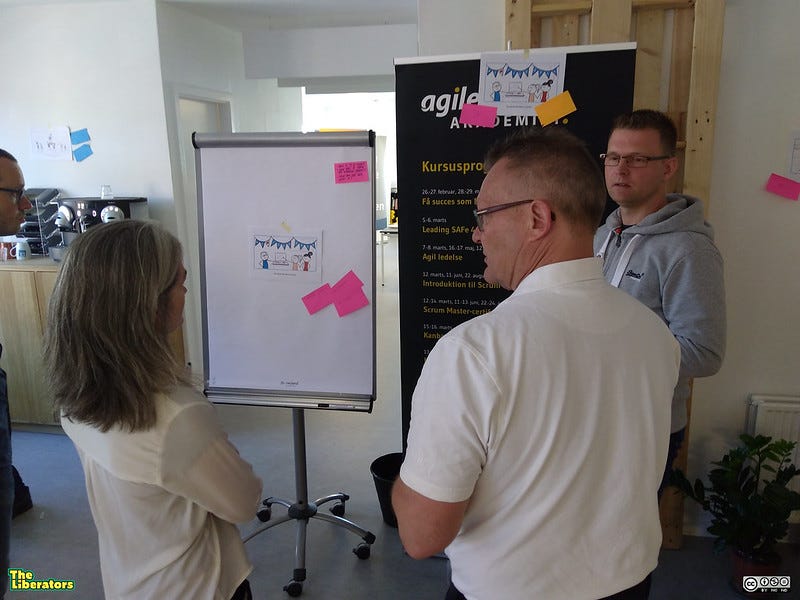
Example of a Shift & Share for Scrum Mythbusters. Participants share their experience with a particular myth in each of the stations, and then rotate
- Appreciative Interviews. This Liberating Structure helps you identify the enablers for success. By starting from what goes well — instead of what doesn’t — it liberates spontaneous momentum and insights for positive change as “hidden” success stories are uncovered. Ask the team to select one myth everyone has experienced and can relate to. Form pairs and sit face-to-face. Give everyone paper to take notes. In turn, interview each other about a personal success story about how they’ve dealt with the myth. Ask questions like “What happened?” and “What made the success possible?”. Form groups of four. Retell the story of your partner. Identify and collect insights together.
- What, So What, Now What? ‘What, So What, Now What’ is a foundational Liberating Structures that helps by asking us to step back and consider what is going on. It structures our thinking by breaking our experience down into three steps: “What do we notice?”, “So, what does this mean?” and “Now, where do we go from here?”. The flow of this Liberating Structure makes it ideally suited to reflect on the Scrum myths. Considering using 1–2–4-ALL to answer the questions. This prevents a group discussion and allows everyone to reflect and contribute.
- Mad Tea. An energetic way to explore the Scrum myths is Mad Tea. Ask the team to form two concentric circles and pair up with the person standing directly across them. As the facilitator, you offer the pairs a myth to discuss. In total, they have 1 minute. It’s up to the pairs to distribute the time equally. After 1 minute, the outer circle moves one step to the right and as such forms a new pair. Repeat, until everyone has arrived again with the person they started. Optionally, discuss key takeaways with the entire group.
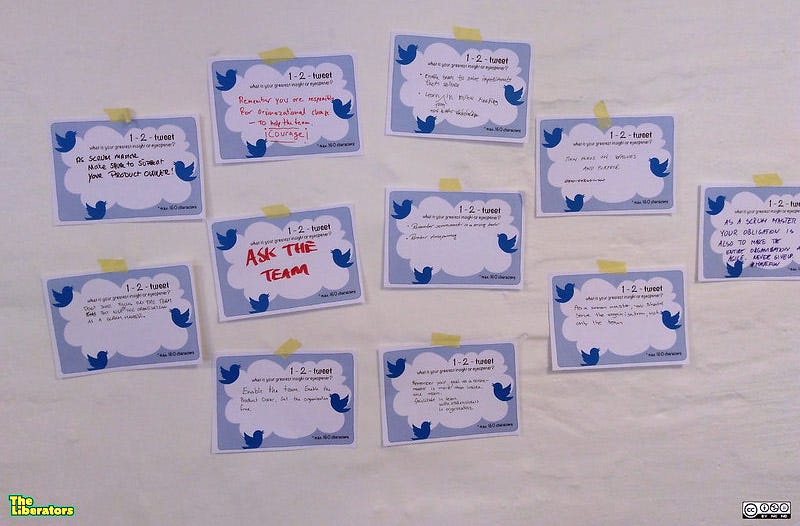
Some of the 15% Solutions and insights emerging from a Scrum Mythbusters session
Closing words
In this blog post, we offered inspiration for when & how to use the Scrum Mythbusters exercise. We hope it will trigger valuable conversations in and around your Scrum Team, improve your understanding of the Scrum Framework, and grow a stronger Scrum community. You can order a deck with 39 Scrum Mythbusters cards here. Enjoy using them!

See how you can support us at patreon.com/liberators
